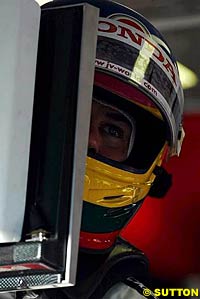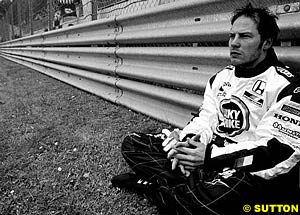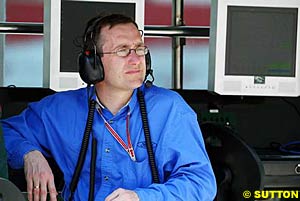Atlas F1 Magazine Writer
Fresh from the Formula One paddock
A 30-minute road journey from William Shakespeare's birthplace of Stratford-Upon-Avon to BAR-Honda's headquarters in Brackley leads straight past David Richards' office at Prodrive in Banbury, so the designer-stubbled Welshman could be forgiven for drawing upon a variation of the bearded Bard's Hamlet soliloquy: To JV or not JV; that is the question...
Unlikely as it may seem, the BAR boss and Formula One's original grunge rocker, Jacques Villeneuve, could well be bedfellows come the new season. In fact, a reconciliation with the team originally formed in the Canadian's Rebel With A Cause image probably has more chance of flying than the retention by BAR of Jenson Button.
Despite all the warning signs, Villeneuve (and Craig Pollock, of whom more anon) failed to negotiate alternate employment, and so it came to pass that a very unhappy Jacques sat out this season, his only appearance in a F1 car being at Goodwood, when he drove the Ferrari 312T3 his (late) father Gilles had raced to victory in the 1978 Canadian Grand Prix. But, even that was deceptive: JV wore a replica of the elder's brown-orange helmet, so those famous pink/mauve-blue/yellow/green helmet colours have sat out even longer than the Fastest Specs in the West.
But, we digress. The situation between team boss and 1997 champion had always been, at best, brittle, particularly as Richards it was who replaced Villeneuve's friend, mentor, manager and confidant Pollock, who was forced to 'step down' at end-2001 through board pressure four years after founding British American Racing, as it was originally known, via massive wedges of British American Tobacco money. And, 'massive' was more than merely an operative word – only the best went into every single aspect of the operation, from wind tunnel and manufacturing equipment through systems to staff canteen and gymnasium - but, to BAT's dismay, results were short and excuses long.
Still, such was the publicity generated through Villeneuve, predominantly via the structured exploitation of his free-spirited ways and image, that BAT reckoned direct investment in its own, controllable Formula One team brought greater returns than those provided by traditional sponsorship programmes. Despite regular rumours that BAT was looking to off-load BAR, there never were any serious plans to do so despite distinct results droughts, and, if anything, the company invested ever-increasing sums in the operation. And, the mainstay was, of course, JV.
With Pollock gone from the day-to-day management (he remains a shareholder), JV was vulnerable, but only once Richards had found a substitute, which he did, in mid-2002, in the form of Jenson Button, who had long been friendly with Richards' eldest son. So, where Pollock had kept Number One drives within his 'family', Richards did, too.
It seemed more like the Dream Team, two quintessential Brits at BAR, than even the swarthy Mediterranean pairing of Fernando Alonso and Flavio Briatore at Button's ex-team, Renault, and, Villeneuve should have got the message when Richards' suggested the Canadian take a year's sabbatical in IRL or CART, with the promise of a return to F1 in 2004, whilst BAR regrouped. When that option was refused, Richards was rumoured to have offered Villeneuve a reduced financial package in exchange for a longer contract. Again he failed to convince the head-strong Jacques.
By the second race of last year it was clear that Button was zipping Villeneuve. At BAR's 2003 launch Villeneuve had been rather disparaging about his future teammate, but was soon made to eat his words. To his credit, he did. But, garage 'ownership' of the team was sliding from the feisty Villeneuve's side to the bright Button's, and a less obstinate man would have digested the graffiti writ large in bold letters on pit walls from Australia to America and laid plans. Yet, what fuelled Jacques flames was that, when BAT needed promotional work, it was still to him, despite his prickly reputation and patent reluctance to glad hand and press flesh, that the cigarette company turned. It was all to do with image, you see.
"Maybe one or two of the budget teams should go to the wall to allow us to run a third car," said the staffer almost in the same breath – fully aware that Villeneuve and Pollock were outside cruising the streets of the Principality in the latter's Indy-replica Corvette. Villeneuve looked as cool and unruffled as ever, and, for an unemployed man, seemed in excellent spirits. His trainer, former MotoGP racer Erwin Gollner, maintains that 33-year old JV, five years younger than Nigel Mansell was when the Brit took his championship, is as fit as he ever was. More importantly, said the Austrian, Jacques was refreshed and raring to race. Oh, how bitter must have been Jacques' realisation that weekend that 'his' team could provide a car capable of third on Monaco's grid and second in the race.
So, what are the chances of Jacques returning to race with BAR? If a return by two-time champ Mika Hakkinen (36), who was never forced from the sport, can be taken seriously, why not that by a champion three years younger, one who has no domestic commitments and still has the odd score to settle? If former champs Niki Lauda and Alain Prost could return and win, why not JV; if Mansell can still dream of return, why cannot Villeneuve actually do so?
If, as expected, the Contract Recognition Board rules in favour of Button's move to Williams, it is all be over BAR the shouting for Richards and the protege in whom he had placed so much faith; if the CRB rules for the team, it will be all over BAR the money. So, either way, despite Richards' unstinting belief that reconciliation could be effected between BAR and Button, the latter's unswerving intention of driving blue/white car next year seems set to hold sway. And, never in the history of F1 has reconciliation been possible unless both parties need it, and Button clearly has no need for BAR for some reason.
And, if not JV, who then? Anthony Davidson? The young BAR tester acquitted himself extremely sensibly on Fridays this year, but as Antonio Pizzonia and Marc Gene proved, stage fright is all too common on Sundays, and, let us face facts, Davidson, nice enough guy he is, did not blow back too many hairlines when he had a double Grand Prix crack with Minardi back in 2002.
Jarno Trulli? Well, the Monaco winner may have a funky, though, not 'macho', image, but does he have the ultimate ability that wins races regularly and, then, championships for a team clearly on the up? JV did win 11 races, took 13 poles and fastest laps. So, who else could be on Richards' list? David Coulthard - never forget that DC made way for JV at Williams in 1996 after a CRB hearing a year earlier, so a reverse link exists, but an unshaven DC donning oversized, inside-out khaki overalls and a bush cap to do Lucky Strike promos true justice? Don't think so, somehow.
So, in the final analysis, JV seems the man most likely to suit team owner BAT if the CRB does what is most likely. Of course, he and Richards may not be the best of friends, but, they NEED each other, that overrides all other considerations in the reconciliation process. In fact, so great is JV's need that he may even drive for zero, whilst BAR trousers Williams' compensation. So, consider the scenario: Button salary and bonuses saved, compensation from Sir Frank, and JV for nothing. Imagine Shakespeare on that one: To JV for free or not; that is THE question...
A year ago, at the 'Newburgring' round, a Minardi sponsor hosted a two-Hour Formula One Karting Extravaganza. The event was a roaring success and pitted the full F1 spectrum, from media people through caterers and marketing people to technicians and consultants, against itself. Teams were generally made up of four to six drivers, and stints of 20 – 30 minutes were the norm
There was one exception: a kart entered by A Purnell, Esq. ran through without driver change. When questioned on the matter, Jaguar's PR guru advised that "Tony raced karts whilst still at school, and still likes to keep his hand in."
In essence the concept is simple: lots drawn to determine starting positions for Friday's race, with the grid of the second event to be their reverse; points allocated on the basis of result over starting position (i.e., a driver starting and finishing first gets zero points, one starting 20th and finishing ninth is granted 11 points); highest points scorer to start first, lowest last, with ties broken on fastest lap basis.
So far, so good. Visions of manic races abound, of Zsolt Baumgartner, who started first holding off Michael Schumacher, from 15th, as a whole posse of cars sears towards the line. Next day, Schumacher starts fifth, finishes third, to claims a total haul of 16 points and second on the grid. Nick Heidfeld, from 11th to third on Friday and ninth to first on Saturday after the field ahead of him spun on Lap One, claims 17 and pole position for Jordan.
Meanwhile, Friday crowds are up, TV companies love Saturday's race, and Bernard Charles Ecclestone is seen grinning for the first time in many months. A certain Japanese computer programmer, meanwhile, has left Renault, gone freelance, and sold his start systems to eight teams for zillions.
Then the Devil looks into the detail, and the dreaming stops. For starters, if you'll excuse the weak pun, three full blown launches from the line in a single weekend, and, in order to score maximum overtaking points these are vital, are more than most cars can take, and, apart from collision cost considerations, there are safety issues surrounding three blasts into Ste Devote on three separate days. And, for that matter, at the Nurburgring and virtually every circuit on the trail.
Forget not that the last two deaths during a Grand Prix weekend (Monza 2000 and Australia 2001) occurred during their respective opening laps, and that Fernando Alonso's Indianapolis crash, which probably began Ralf Schumacher's massive accident, came as a result of the opening lap clash between tail enders. Now draw a Ferrari and a Minardi side-by-side, and watch the fibre fly three times. So, either a tripling of the danger factors, or regular six-lap SC sprees on consecutive days.
To justify the concept on the basis that Grands Prix grids before the inception of the World Championship were decided by lottery is disingenuous: those periods accepted death as easily as they did torture and humiliation during times of war, and, in any event, speeds were far slower. To spice up qualifying without resorting to lotteries and Mickey Mouse races is simple: bring back, instead, the manic 12-lap qualifying of old. It worked, filled the TV screens and delivered more pole winners than the present system.

 Of course, last week any suggestions that JV and DR would talk, let alone negotiate, were greeted with vehement derision, with the Canadian's detractors, of which there are scores in the paddock, pointing to irreconcilable differences between the two before Japan last year, when Villeneuve was either pushed from high or pole vaulted out of the team. Of course, the move let Taku Sato into a Honda-powered car on a Honda circuit before his home crowd, and the Japanese driver certainly seized the day, taking the car he had tested all season for Villeneuve, then the second-highest earning driver in the sport, to a fine sixth – which equalled JV's best placing of the year.
Of course, last week any suggestions that JV and DR would talk, let alone negotiate, were greeted with vehement derision, with the Canadian's detractors, of which there are scores in the paddock, pointing to irreconcilable differences between the two before Japan last year, when Villeneuve was either pushed from high or pole vaulted out of the team. Of course, the move let Taku Sato into a Honda-powered car on a Honda circuit before his home crowd, and the Japanese driver certainly seized the day, taking the car he had tested all season for Villeneuve, then the second-highest earning driver in the sport, to a fine sixth – which equalled JV's best placing of the year.
 This year, with JV gone, Button has been spearhead, but, just recently, at a Lucky Strike function in Monaco, a BAT staffer was lamenting the Canadian's absence. "All very well to have Jenson, podium placer and pole winner and all, doing promos, but he isn't quite Jacques, is he?" In fact, stories abound that BAT was reluctant to go along with Richards' release of the Canadian, but had little say in the matter: Button was onboard for two years, which, as has become abundantly clear, expire this season, and Sato need to be employed in a race capacity to keep Honda sweet.
This year, with JV gone, Button has been spearhead, but, just recently, at a Lucky Strike function in Monaco, a BAT staffer was lamenting the Canadian's absence. "All very well to have Jenson, podium placer and pole winner and all, doing promos, but he isn't quite Jacques, is he?" In fact, stories abound that BAT was reluctant to go along with Richards' release of the Canadian, but had little say in the matter: Button was onboard for two years, which, as has become abundantly clear, expire this season, and Sato need to be employed in a race capacity to keep Honda sweet.

 And it is from this branch of the sport, by any reckoning the purest form of motor racing on our planet, that Purnell has gleaned ideas for his Qualifying proposal, which incorporates two point-less races, one each on Friday and Saturday, to determine grid positions.
And it is from this branch of the sport, by any reckoning the purest form of motor racing on our planet, that Purnell has gleaned ideas for his Qualifying proposal, which incorporates two point-less races, one each on Friday and Saturday, to determine grid positions.
|
Contact the Author Contact the Editor |
Please Contact Us for permission to republish this or any other material from Atlas F1.
|
Volume 10, Issue 33
Articles
Formula What?
Bjorn Wirdheim: Going Places
Ann Bradshaw: Point of View
2004 Hungarian GP Review
2004 Hungarian GP Review
Technical Review: Hungary 2004
The Business of Winning
Stats Center
Qualifying Differentials
SuperStats
Charts Center
Columns
The F1 Insider
Season Strokes
On the Road
Elsewhere in Racing
The Weekly Grapevine
> Homepage |
